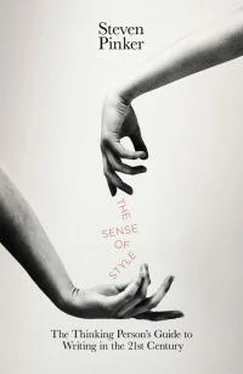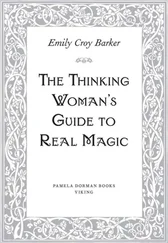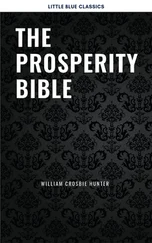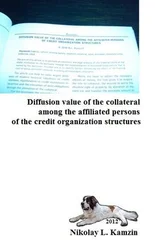Attachment to the phrase next door. Finally, we get to the panel on sex with four professors. Here we have a bias that is mainly geometrical. Go back to the trees on page 117. Why is the tree on the bottom, with the unintended meaning, the one the reader arrived at? The difference is in where the phrase with four professors is attached. When given a choice, readers tend to attach phrases lower in the tree rather than higher. Another way of putting it is that they like to absorb words into the phrase they are working on for as long they can, rather than closing off the phrase and figuring out somewhere else to place the incoming words.
Since readers tend to link a phrase to the words that came just before it, they will misunderstand a sentence when the writer had a more remote association in mind. Together with the sex with professors, this bias explains the foreplay of several weeks’ duration, the cow that does not smoke or drink, the job candidate with no qualifications, the cyclist who was killed twice, the trail that was mistaken for a bear, and the coup that rattled Beijing.
Many authors of stylebooks, such as Strunk and White, try to protect writers against this accidental hilarity with the advice to “keep related words together.” Unfortunately, the advice is unhelpful because it is stated in terms of strings rather than trees. In a panel on sex with four professors, trying to keep related words together won’t help: they already are together. The mischievous phrase on sex is smack-dab next to the related phrase a panel on the left, where it belongs—but it’s also smack-dab next to the unrelated phrase four professors on the right, where it doesn’t. What the writer has to worry about is connectedness in the tree ( a panel on sex versus sex with four professors ), not just adjacency in the string. In fact the obvious way to clarify the sentence—flipping the order of the two phrases, yielding a panel with four professors on sex —pulls related words apart ( a panel and on sex ) rather than keeping them together, at least in the string. As the diagrams on pages 128 and 129 show, the related words are still connected in the tree, just in a different order.
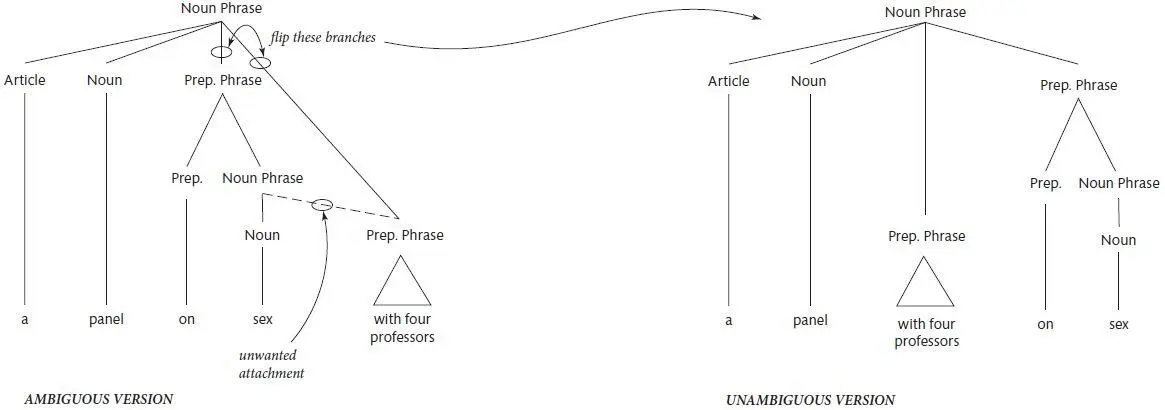
The advice is better stated as “pull unrelated (but mutually attracted) phrases apart.” If the panel had been about controlled substances rather than amorous interactions, the opposite order would be safer: A panel with four professors on drugs promises as interesting an evening as the panel on sex with four professors, but the writer would be better off wording it as a panel on drugs with four professors. That’s because of the effect of statistically frequent word sequences: the pair sex with attracts the phrase on the right; the pair on drugs attracts the phrase on the left. Writers need to look in both directions, and shunt phrases around to keep them from dangerous liaisons with an inappropriate next-door neighbor. Here are some reorderings of the examples from pages 117–18, with the ambiguities eliminated:
For several weeks the young man had involuntary seminal fluid emission when he engaged in foreplay.
Wanted: Man that does not smoke or drink, to take care of cow.
This week’s youth discussion in the church basement will be on teen suicide.
I enthusiastically recommend, with no qualifications whatsoever, this candidate.
Prosecutors yesterday confirmed they will appeal the “unduly lenient” sentence of a motorist who escaped prison after being convicted for the second time of killing a cyclist.
A teen hunter has been convicted of second-degree manslaughter for fatally shooting a hiker he had mistaken for a bear on a popular Washington state trail.
The guideline to move a phrase close to the words it belongs with, and away from those it doesn’t belong with, is useful only insofar as the rules of English syntax allow a phrase to be moved. Our language puts us at a disadvantage here. In many other languages, such as Latin and Russian, writers have the freedom to scramble the order of words to suit their rhetorical purposes, because case markers on the nouns, or agreement markers on the verbs, will keep the relationships straight in the reader’s mind. English, which has a rudimentary system of case and agreement, must be more tyrannical about order.
This puts the writer in a bind. The rules of English syntax force him to put the subject before the verb, and the verb before the object. But he may not want the reader to think about the content of the subject before she thinks about the contents of the verb and object.
Why should a writer want to control the order in which the reader thinks her thoughts? Preventing unwanted attachments, as we have just seen, is one reason. There are two others, and each is a monumental principle of composition.
Save the heaviest for last . The Scottish prayer asks the Lord to deliver us from “ghoulies and ghosties and long-leggedy beasties and things that go bump in the night”—not from “things that go bump in the night and long-leggedy beasties and ghoulies and ghosties.” The order fits with our cognitive processes: it’s taxing to work on a big heavy phrase ( things that go bump in the night ) while you are holding in memory an incomplete bigger phrase it’s part of (in this case, the four-part coordination embracing things, beasties, ghoulies, and ghosties ). A big heavy phrase is easier to handle if it comes at the end, when your work assembling the overarching phrase is done and nothing else is on your mind. (It’s another version of the advice to prefer right-branching trees over left-branching and center-embedded ones.) Light-before-heavy is one of the oldest principles in linguistics, having been discovered in the fourth century BCE by the Sanskrit grammarian Pāṇini. 32It often guides the intuitions of writers when they have to choose an order for items in a list, as in life, liberty, and the pursuit of happiness; The Wild, The Innocent, and The E Street Shuffle; and Faster than a speeding bullet! More powerful than a locomotive! Able to leap tall buildings in a single bound!
Topic, then comment. Given, then new. These are more precise versions of the Strunkian advice to “put the emphatic words of a sentence at the end.” Paul McCartney was mindful of the advice when he sang, “So may I introduce to you, the act you’ve known for all these years: Sergeant Pepper’s Lonely Hearts Club Band!” Once he had the listeners’ attention, and reminded them that they were there to be introduced to someone, he used the end of the sentence to provide the newsworthy information; he did not sing, “Sergeant Pepper’s Lonely Hearts Club Band, the act you’ve known for all these years; may I introduce them to you?” 33Once again, it’s good cognitive psychology: people learn by integrating new information into their existing web of knowledge. They don’t like it when a fact is hurled at them from out of the blue and they have to keep it levitating in short-term memory until they find a relevant background to embed it in a few moments later. Topic-then-comment and given-then-new orderings are major contributors to coherence, the feeling that one sentence flows into the next rather than jerking the reader around.
Читать дальше
